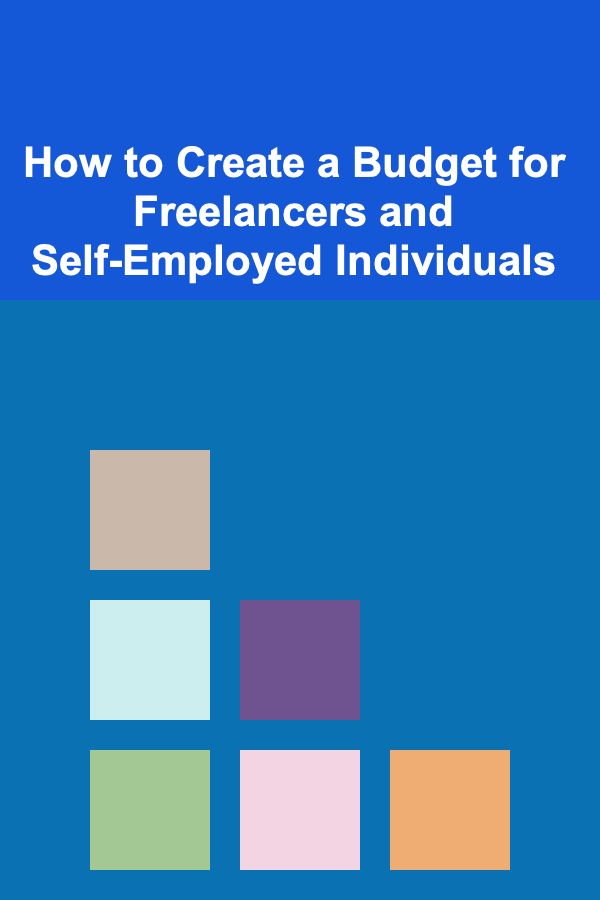
How to Create a Budget for Freelancers and Self-Employed Individuals
ebook include PDF & Audio bundle (Micro Guide)
$12.99$9.99
Limited Time Offer! Order within the next:

Managing finances can be a tricky task for freelancers and self-employed individuals. Unlike salaried workers, who typically receive a fixed income on a regular schedule, freelancers have to deal with fluctuating income and a more complex tax structure. To stay financially healthy and maintain a sustainable business, it's essential to create a budget that can guide you through these uncertainties while still allowing for growth, flexibility, and stability.
In this article, we'll break down the steps for creating an effective budget for freelancers and self-employed individuals, ensuring you're prepared for both expected and unexpected financial situations.
Understand Your Income Streams
For freelancers and self-employed individuals, one of the first and most important tasks is understanding where your income is coming from. Unlike a standard paycheck, your income may come from multiple clients, projects, or gigs. It's essential to have a clear view of your different income sources and how often you receive payments from each.
Steps to Assess Your Income Streams:
- Identify Clients or Projects: List all the clients, businesses, or platforms you work with. Note how often you get paid from each (e.g., weekly, monthly, per project).
- Estimate Variability: Recognize that freelance income tends to fluctuate. Some months may be more lucrative than others, depending on workload and market demand. Make a list of the most reliable and unpredictable sources.
- Calculate the Average: Look back at the past 6 to 12 months to calculate the average income you've made per month. This will give you a good baseline for budgeting.
Example:
If you have three clients, with Client A paying you $2,000 per month, Client B paying $1,000 monthly, and Client C paying per project (averaging $2,500 every two months), your monthly average income is approximately $2,000. From here, you can adjust for any additional income sources or irregular payments.
Separate Business and Personal Expenses
One of the most critical elements in budgeting for self-employed individuals is keeping business and personal finances separate. Mixing these can lead to confusion, missed deductions, and poor financial management. The goal is to track business expenses accurately for tax purposes while also managing personal expenses effectively.
Steps to Separate Your Expenses:
- Open Separate Accounts: Consider having separate bank accounts for personal and business expenses. This makes it easier to track income and expenditures and keeps your financial records clean.
- Track Business Expenses: Make sure to keep records of any purchases directly related to your business, such as software subscriptions, office supplies, marketing costs, and professional services.
- Personal Expenses: Keep track of all personal spending (e.g., rent, utilities, groceries, insurance). This will help ensure you're not using business income for personal needs.
Example:
Set up two accounts at your bank: one for your personal savings and spending, and another specifically for your freelance income and business-related expenses. This separation ensures you can easily allocate the correct portions for taxes and savings.
Estimate Your Fixed and Variable Costs
Once you've identified your income and separated business and personal finances, the next step is to break down your expenses. This will involve both fixed and variable costs.
Fixed Expenses:
These are regular, recurring costs that don't change from month to month. They might include:
- Rent or mortgage payments
- Health insurance premiums
- Software subscriptions
- Loan payments
Variable Expenses:
These are costs that can fluctuate month to month based on the work you do, how much you produce, and your lifestyle. Examples include:
- Utilities (e.g., electricity, internet)
- Office supplies
- Marketing and advertising costs
- Business travel or meals
- Taxes (more on this below)
Steps to Categorize Your Expenses:
- Review Your Past Expenses: Look at your bank statements or accounting records over the last 3-6 months to assess both fixed and variable costs.
- Create Categories: Create categories for all your costs, including business-related and personal expenses.
- Adjust Regularly: As your business grows or changes, your expenses will likely evolve. Stay flexible and adjust your budget accordingly.
Set Aside for Taxes
As a freelancer or self-employed person, taxes are a significant part of your financial planning. Unlike employees, you're responsible for both income and self-employment taxes. It's essential to set aside a percentage of your income for taxes to avoid financial strain when tax season arrives.
Steps for Tax Planning:
- Know Your Tax Rate: Determine what percentage of your income you need to set aside for taxes. Generally, freelancers should set aside 25-30% of their income for federal taxes, but this may vary depending on your location and business type. Check with a tax professional to determine your exact tax obligations.
- Create a Tax Savings Account: Open a separate savings account specifically for tax savings. This will help you resist the temptation to dip into this money for other expenses.
- Quarterly Payments: In many countries, freelancers and self-employed individuals must pay taxes quarterly. This is often based on the income you've earned in the previous quarter. Be sure to track your income carefully to avoid penalties for underpayment.
Example:
If your monthly income is $3,000, setting aside 30% for taxes would mean saving $900 each month. Over the course of the quarter, you'd save $2,700 to cover your tax bill.
Build an Emergency Fund
Given the unpredictable nature of freelancing, an emergency fund is crucial. This fund will act as a financial cushion during months with lower income or when unforeseen circumstances arise, such as medical emergencies or equipment failure.
Steps to Build Your Emergency Fund:
- Start Small: Aim to save at least 3-6 months' worth of living expenses. If that seems daunting, start by saving smaller amounts, such as $100-200 per month, and gradually increase the amount as your business grows.
- Automate Your Savings: Set up an automatic transfer to your emergency fund each month, so you're less likely to spend that money.
- Only Use for Emergencies: Only dip into this fund in true emergencies (e.g., unexpected medical costs or a sudden dip in income). This will ensure your emergency fund remains intact for future needs.
Example:
If you need $2,000 per month to cover your living expenses, aim for an emergency fund of $6,000-$12,000. Gradually save this amount over time by putting aside a fixed amount each month.
Account for Growth and Business Investments
While saving for emergencies and setting aside money for taxes are essential, don't forget to allocate funds for your business's growth. Whether it's investing in new equipment, taking a course to enhance your skills, or hiring subcontractors to help you expand, having a budget for reinvesting in your business is vital for long-term success.
Steps for Growth Planning:
- Identify Potential Investments: Think about where your business could benefit from investments, such as new software, tools, or marketing campaigns.
- Allocate a Percentage: Consider setting aside a specific percentage of your income (5-10%) for business reinvestment. For instance, if you make $3,000 in a month, you could allocate $150-$300 towards business growth initiatives.
- Track ROI: Regularly evaluate whether these investments are yielding positive results. If a marketing campaign isn't bringing in new clients, you may need to reallocate that budget.
Example:
If you want to grow your freelance business by investing in a new website, set aside a portion of your monthly income (say $200) for this purpose. After a few months, you'll have the budget to invest in a professional website that can attract more clients.
Monitor and Adjust Regularly
Finally, a budget isn't a static document---it needs to evolve. As your business grows and your expenses change, it's crucial to revisit your budget regularly to make adjustments.
Steps for Ongoing Budget Management:
- Review Monthly: Set aside time each month to review your income, expenses, savings, and tax planning. If your income has increased or decreased, adjust your allocations accordingly.
- Track Performance: Use accounting software or spreadsheets to track your progress. Many freelancers use tools like QuickBooks, FreshBooks, or Wave to make budgeting and tracking simpler.
- Stay Flexible: Your financial situation as a freelancer will change. Keep a flexible mindset and adjust your budget as needed, especially if you experience a particularly slow month or a busy season.
Conclusion
Creating a budget as a freelancer or self-employed individual is both essential and empowering. By understanding your income streams, separating your finances, planning for taxes, and setting aside funds for emergencies and growth, you can maintain financial stability and reduce the stress of freelancing. The key is to remain proactive and adaptable in your financial planning, ensuring that your business and personal life can thrive without compromising either.
With a well-organized budget, you'll have the freedom to focus on the creative and strategic aspects of your business while knowing that your finances are under control.
Reading More From Our Other Websites
- [Personal Finance Management 101] How to Create a Financial Safety Net
- [Small Business 101] Top Payroll Companies for Small Business: Best Options for 2025
- [Needle Felting Tip 101] How to Design Needle‑Felted Pop‑Culture Figures with Accurate Proportions
- [Organization Tip 101] How to Organize Your Digital Documents for Easy Retrieval
- [Home Lighting 101] How to Use Chandeliers to Elevate Your Home's Interior
- [Home Family Activity 101] How to Plan a Family Talent Night with Fun Performances
- [Home Space Saving 101] How to Create a Functional Space Saving Utility Room
- [Personal Investment 101] How to Create Profitable Passive Income Streams through Deep Learning Algorithms
- [Organization Tip 101] How to Use Magnetic Strips for Small Item Storage
- [Personal Financial Planning 101] How to Track Your Net Worth and Why It Matters

How to Create a Renovation Budget Without Breaking the Bank
Read More
How to Invest Wisely for Beginners Without Taking Too Many Risks
Read More
Mastering Financial Analysis: Advanced Techniques for Evaluating Investments and Risk
Read More
How To Get Better at Valorant
Read More
How to Run a Successful Baseball Tryout
Read More
How to Choose the Right Zumba Shoes for Your Foot Type
Read MoreOther Products

How to Create a Renovation Budget Without Breaking the Bank
Read More
How to Invest Wisely for Beginners Without Taking Too Many Risks
Read More
Mastering Financial Analysis: Advanced Techniques for Evaluating Investments and Risk
Read More
How To Get Better at Valorant
Read More
How to Run a Successful Baseball Tryout
Read More